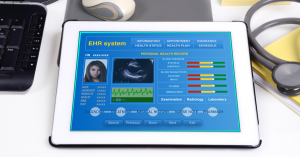Estimated reading time: 4 minutes
Healthcare services have expanded their offering over the years, and especially recently in response to the ongoing Public Health Crisis that has impacted our country and world. Technology in healthcare is growing more intelligent as time goes on, especially as AI and Advanced Analytical tactics are jumping in to simplify processes. Not only are patient experiences being enhanced, but clinical workflows are being overlooked more specifically to ensure employees can do their jobs as effectively and swiftly as possible. That’s where ensuring that interoperability, or the ability of two or more systems to exchange health information and use this data successfully once it’s received, comes into the picture to ensure confirm that technology tactics are utilized accurately and efficiently.
Achieving Healthcare Interoperability
More than 50% of doctors and other clinicians have begun to adopt and optimize Electronic Health Records (EHRs) and other health information exchange (HIE) methods. Clinicians are able to obtain patient records and information directly at their fingertips at all times, making it easier to process transactions such as intake, Post-discharge outreach, patient preference tracking, and even administering point-of-care surveys to collect feedback from patients who recently received care. With better digitalized access to such data groups, healthcare professionals are able to add a personalized, yet optimized touch on the nature of such items.
In today’s health interoperability ecosystem, organizations that choose to identify with these methods are those ones experiencing the largest amount of success. The overall goal remains a constant in trying to provide a better patient experience with a comprehensive, complete profile, capable of driving better decision-making flows when a patient would need an intervention, how and when to address any of their specific needs that come up, and how to push for better outcomes every single time.
 Other technology pieces such as AI and Smart Analytics have driven to improving the overall coordination of delivered care for patients receiving care. Any given patient can come into contact with many different professionals during their stay in a healthcare facility; from physicians and nurses to even specialists and triage administrative staff members, there is a lot of in-person contact taking place during this time. Such interactions can look like the following instances:
Other technology pieces such as AI and Smart Analytics have driven to improving the overall coordination of delivered care for patients receiving care. Any given patient can come into contact with many different professionals during their stay in a healthcare facility; from physicians and nurses to even specialists and triage administrative staff members, there is a lot of in-person contact taking place during this time. Such interactions can look like the following instances:
- Notifications & Alerts – A Doctor will be notified when one of their own patients is checked into the emergency department, so effective communications can be delivered upon discharge to ensure that everyone is on the same level of understanding, if a follow-up appointment were to be scheduled.
- Monitoring Medications – A fully history of medications and prescriptions will be provided to any new physician that gets added to a patient’s lineup, so they can keep track of any differences and address any red flags that are notated.
- Referral Assistance – Instead of waiting on hold and playing phone tag with receptionists, healthcare professionals can submit referral slips and letter right through the digital EHR platform to ensure that there is no delay or inconvenient road bump, prohibiting the patient from receiving the proper care.
- Care Transitions – It’s more common than you’d think, but patients change providers all the time, perhaps they weren’t receiving their ideal care methods or they move away and require medical care in a new geographical location; whatever the reasoning, no patient should ever be faced with the complication of a care gap due to information not being easily transferable from one location to another. Such tasks can be done and processed digitally all through the usage and adoption of successful EHR platforms.
Understanding EHR Platforms
A seamless system of care efforts where patients have access to their health records, electronically, and physicians are able to better communicate to and with their patients is the ideal way to provide care. Almost every stakeholder is involved in these care methods and at their very best, these tactics are providing important foundational footing for the future of interoperability functionalities in healthcare environments everywhere.
 The average physician spends around 16 minutes and 14 seconds per encounter using EHRs, with chart review and documentation functions amounts taking place for the rest of the time, according to research conducted by the Annuals of Internal Medicine. Assistive tools called clinical decision support, have been implemented to have cut back on time that healthcare professionals are manually tapping through options throughout the platform, in a smarter bot-oriented flow. Such integrations have been proven to help clinicians and physicians to cut out idle downtime and keep workflows operating in smooth manners.
The average physician spends around 16 minutes and 14 seconds per encounter using EHRs, with chart review and documentation functions amounts taking place for the rest of the time, according to research conducted by the Annuals of Internal Medicine. Assistive tools called clinical decision support, have been implemented to have cut back on time that healthcare professionals are manually tapping through options throughout the platform, in a smarter bot-oriented flow. Such integrations have been proven to help clinicians and physicians to cut out idle downtime and keep workflows operating in smooth manners.
In the case of COVID-19 and the ravaging Delta Variant, EHRs must provide the ability for clinicians to easily analyze patient data, to best discover new treatment plans, uncover safety issues, and identify any unusual symptoms that present themselves throughout the isolation period. Overall, HER platforms are the way to go when it comes to accomplishing a sense of established, modern means of providing care for patients, especially during a Pandemic.

